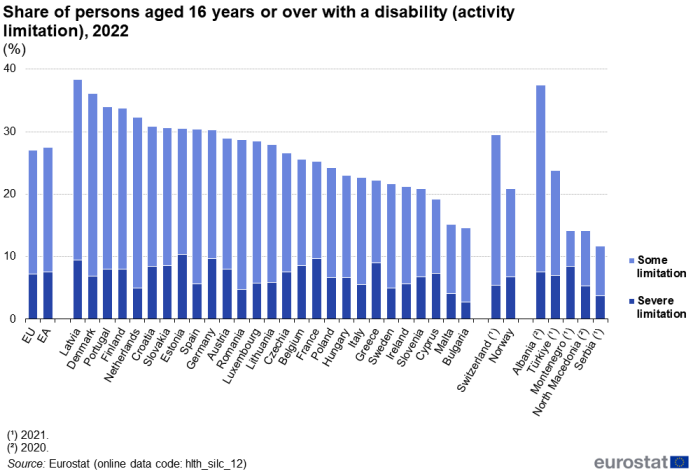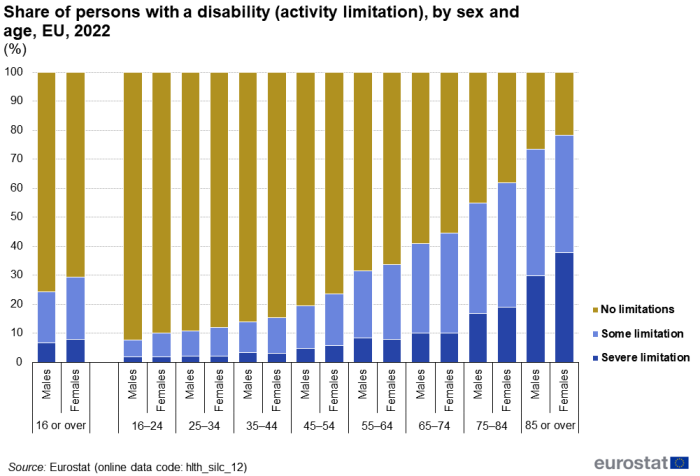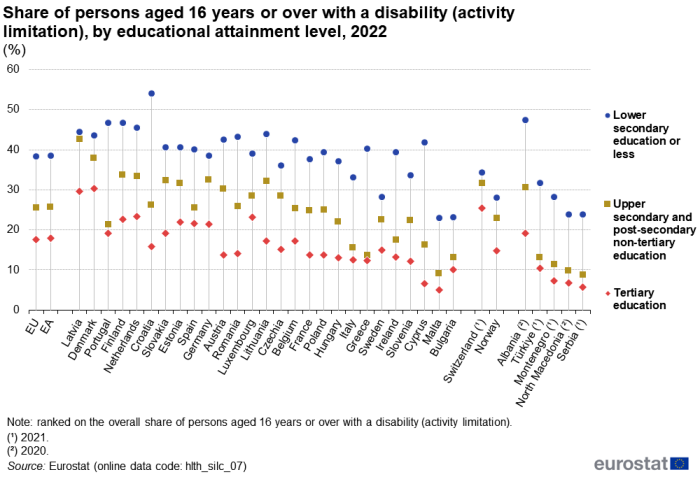Self-reported disability (limitation in usual activities due to health problems)
More than one-quarter of the EU population aged 16 years and over had a disability (activity limitation) in 2022.
In the EU, 27.0 % of the population aged 16 years and over reported some or severe long-standing limitations in their usual activities due to health problems (hereafter referred to as a disability) in 2022: 19.8 % reported some limitation and 7.2 % reported a severe limitation – see Figure 1.
Across the EU Member States, the share of people who reported a disability in 2022 ranged from 14.6 % in Bulgaria and 15.1 % in Malta to more than one-third in Finland (33.9 %), Portugal (34.0 %), Denmark (36.1 %) and Latvia (38.5 %). Looking in more detail, Estonia recorded the highest share of people reporting severe limitation (10.3 %), while Denmark had the highest share of its population reporting some limitation (29.2 %).
 Figure 1: Share of persons aged 16 years and over with a disability (activity limitation), 2022
Figure 1: Share of persons aged 16 years and over with a disability (activity limitation), 2022
(%)
Source: Eurostat (hlth_silc_12)
Self-reported disability analysed by age and sex
In 2022, males were less likely than females to report a disability; see Figure 2. This pattern was repeated in all of the EU Member States, with the largest gender gaps recorded in Portugal, Romania and Latvia (at least 9.0 percentage points (pp)). Cyprus, Slovenia and Ireland had the smallest differences between the sexes, as the share of females reporting a disability was less than 2.0 pp above the corresponding share for males.
 Figure 2: Share of persons aged 16 years and over with a disability (activity limitation), by sex, 2022
Figure 2: Share of persons aged 16 years and over with a disability (activity limitation), by sex, 2022
(%)
Source: Eurostat (hlth_silc_12)
A further analysis shows that this gender gap was present in the EU in 2022 regardless of the severity of activity limitations – see Table 1. The share of the population reporting a disability with severe limitation was 1.2 pp higher among females than among males, while the gap was wider for people with some limitation, at 3.8 pp.
The gender gap for severe limitation – with higher shares for females – peaked at 2.8 pp in Latvia. Ireland and Austria were exceptions in that they recorded slightly higher shares of males than females reporting severe limitation (both 0.1 pp difference).
The gender gap for some limitation – again with higher shares for females – peaked at 8.3 pp in Portugal, followed by Finland (7.5 pp) and Romania (7.0 pp). The share of people with some limitation was consistently higher for males than for females, the smallest differences being observed in Ireland and Cyprus (0.7 pp and 0.6 pp, respectively).
In this context, it should be remembered that the data are not age standardised and that a greater proportion of females than males are in older age groups.
 Table 1: Distribution of persons aged 16 years and over by disability (activity limitation), analysed by sex, 2022
Table 1: Distribution of persons aged 16 years and over by disability (activity limitation), analysed by sex, 2022
(%)
Source: Eurostat (hlth_silc_12)
Older people were more likely than younger people to report a disability
Self-reported disability has a distinct age pattern, as people in higher age groups are more likely than people in lower age groups to report some or severe limitations – see Figure 3. In 2022, the share of people aged 16–24 years who reported (some or severe) disability was 8.8 % within the EU; the highest share was recorded among people aged 85 years and over, at 76.4 %.
A gender health gap concerning (some and severe) disability could be observed for all age groups in 2022.
The gap was lowest for two of the youngest age groups (25–34 years and 35–44 years), with shares 1.1–1.4 pp higher for females.
It was somewhat higher for the three age groups covering 45 to 74 years, with shares 2.2–4.3 pp higher for females.
It was highest among older people: 7.0 pp higher for people in the age group 75–84 years and 4.8 pp higher for people aged 85 years and over.
However, when focusing just on people reporting severe disability, the gender gap in the EU in 2022 was relatively small, at 1.2 pp across all age groups. A lower proportion of females (than males) reported severe disability in some age groups; this was the case for people aged 16–24, 35–44 and 55–64 years. There was no gender health gap for severe disability for people aged 25–34 years or for people aged 65–74 years. However, the biggest gender gaps for severe disability were recorded in the age groups 75–84 years and 85 years and over, where the shares for females were higher than for males by 2.0 pp and 7.8 pp, respectively.
 Figure 3: Share of persons with a disability (activity limitation), by sex and age, EU, 2022
Figure 3: Share of persons with a disability (activity limitation), by sex and age, EU, 2022
(%)
Source: Eurostat (hlth_silc_12)
Self-reported disability analysed by income and educational attainment
People with higher income levels were less likely to report a disability
In the EU, more than one-third (35.3 %) of the population aged 16 years and over in the first income quintile (the 20 % of the population with the lowest income) reported a disability in 2022. This figure could be compared with 32.1 % for the second quintile, 27.0 % for the third (middle) quintile, 23.2 % for the fourth quintile and 18.4 % for fifth (highest) income quintile (the 20 % of the population with the highest income). In other words, the prevalence of self-reported disability was highest in the lowest income quintile and was progressively lower among higher income quintiles.
Figure 4 shows the share of the population that reported a disability and its relation to income: for reasons of readability, the figure shows the shares for the lowest, middle and highest quintiles only.
In 2022, almost all EU Member States showed a similar pattern to that observed for the EU: higher shares of people who reported a disability were recorded for the first (lowest) income quintile and lower shares for the fifth (highest) income quintile, while the shares for the third income quintile were between these two values – see Figure 4. The only exception was Italy, where a higher share of the population reported a disability within the third income quintile than within the lowest income quintile. It should be noted that Italy – together with Greece and Luxembourg – had one of the highest shares of people in the lowest income quintile perceiving their health as good or very good; see the article on self-perceived health status.
 Figure 4: Share of persons aged 16 years and over with a disability (activity limitation), by income quintile, 2022
Figure 4: Share of persons aged 16 years and over with a disability (activity limitation), by income quintile, 2022
(%)
Source: Eurostat (hlth_silc_12)
The largest differences in the share of the population with a disability between the subpopulations for the lowest and highest income quintiles in 2022 were observed in Croatia (38.6 pp), Latvia (37.2 pp), Estonia (36.9 pp) and Lithuania (35.6 pp). By contrast, relatively little difference was observed between the shares for the lowest and highest income quintiles in Luxembourg (7.7 pp), Greece (6.5 pp) and Italy (5.5 pp).
People with a tertiary level of educational attainment were less likely to report a disability
There are also clear differences when looking at the relationship between disability and educational attainment levels – see Figure 5. In the EU, 38.4 % of the population aged 16 years and over having completed, at most, lower secondary education reported a disability in 2022. This can be compared with 25.5 % among people having completed upper secondary or post-secondary non-tertiary education and 17.5 % among people with a tertiary level of educational attainment. This health gap between educational attainment levels was apparent in all EU Member States, with the same general pattern as that observed for the EU as a whole.
The largest gap in the share of the population reporting a disability between people with the highest and the lowest educational attainment levels was observed in Croatia (38.3 pp), followed by Cyprus (35.3 pp). The smallest gaps were observed in Sweden (13.3 pp), Denmark (13.2 pp) and Bulgaria (13.0 pp).
 Figure 5: Share of persons aged 16 years and over with a disability (activity limitation), by educational attainment level, 2022
Figure 5: Share of persons aged 16 years and over with a disability (activity limitation), by educational attainment level, 2022
(%)
Source: Eurostat (hlth_silc_07)
Source data for tables and graphs
Data sources
Population with a disability in usual activities due to health problems
The data used in this article are derived from EU statistics on income and living conditions (EU-SILC). This source provides annual data for the EU Member States as well as most EFTA and enlargement countries on income, poverty, social exclusion and other aspects of living conditions.
The reference population for EU-SILC is limited to private households and their current members residing in the territory of the surveying country at the time of data collection. People living in collective households and institutions are generally excluded from the reference population. All household members are surveyed, but only those aged 16 years and over are interviewed.
The variables collected are used to assess the limitations people have experienced – because of health problems – in carrying out usual activities for at least six months; the resulting measure is called the global activity limitation indicator (GALI). This is used as a proxy to measure disability. It is also used to calculate the healthy life years indicator. GALI, together with variables on self-perceived health and chronic morbidity (see the article on Self-perceived health statistics) constitute the minimum European health module.
The source is documented in more detail in this background article which provides information on the scope of the data, its legal basis, the methodology employed, as well as related concepts and definitions.
Limitations of the data
All of the indicators presented in this article are derived from self-reported data so they are, to a certain extent, affected by respondents’ subjective perception as well as by their social and cultural background. Despite their subjective nature, the statistics that are presented are considered to be relevant and reliable estimators of the health status of populations as well as good predictors of health care needs; they are also valuable for trend analyses and for measuring socioeconomic disparities.
EU-SILC does not cover the institutionalised population, for example, people living in health and social care institutions who are more likely to face limitations than the population living in private households. It is therefore likely that, to some degree, this data source under-estimates the share of the population with a disability. Furthermore, the indicators presented are not age-standardised and thus reflect the current national age structures. Finally, despite substantial and continuous efforts for harmonisation, the implementation of EU-SILC is organised nationally, which may impact the results presented, for example, due to differences in the formulation of questions or their precise coverage.
Context
Disability statistics are used in measuring the impact and effectiveness of the EU policy aimed at ensuring equal rights for persons with disabilities. Up to now, the EU has adopted several strategies aimed at improving the lives of persons with disabilities by reducing discrimination, inequalities and supporting persons with disabilities to fully enjoy their human rights, fundamental freedoms and EU rights on an equal basis with others. In light of this, the 2021-2030 EU Strategy for the rights of persons with disabilities sets the EU objectives and action priorities in several areas, such as accessibility, citizens’ rights, quality of life, equal access and non-discrimination and the promotion of the rights of persons with disabilities. To find out more, please visit the webpage on the monitoring framework for the objectives and actions of this strategy.
To ensure sound monitoring and reporting of this topic, the European Commission is reinforcing the collection of data on the situation of persons with disabilities in areas where knowledge gaps have been identified, for example in relation to the labour market access.
The EU is also a signatory of the United Nations Convention on the Rights of Persons with Disabilities (CRPD).

